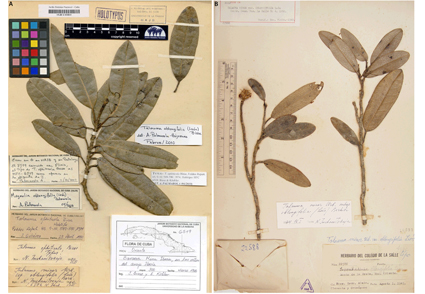Abstract
The taxonomy of Magnolia subsect. Talauma in Cuba has long been debated with many changes in the last few years. New evidence based on ecological, morphological and genetic data has indicated the occurrence of three taxa, with changes in the limits from the latest taxonomic treatment. In this sense, the taxonomy and nomenclature of Magnolia subsect. Talauma in Cuba is reviewed. Diagnoses of all taxa are presented with an identification key, nomenclatural information and distribution. Magnolia subsect. Talauma in Cuba comprises three endemic species: Magnolia orbiculata, M. minor and M. oblongifolia. Magnolia orbiculata is the only species that keeps the same limits as in the previous taxonomic treatments of the group, whereas it is not the same for the northeastern Cuban species.
References
Acevedo-Rodríguez, P. & Strong, M.T. (2012) Catalogue of seed plants of the West Indies. Smithsonian Contributions to Botany 98: 1192. https://doi.org/10.5479/si.0081024X.98.1
Alain, H. (1969) Flora de Cuba, Suplemento. Editorial Sucre, Caracas, 130 pp.
Baillon, H.E. (1866) Mémoire sur la famille des Magnoliacées. Adansonia 7: 1–16, 65–69.
Bisse, J. (1974) Nuevos árboles de la flora de Cuba I. Feddes Repertorium 85: 587–608. https://doi.org/10.1002/fedr.19740850902
Bisse, J. (1988) Árboles de Cuba. Editorial Científico-Técnica, Habana, Cuba, 384 pp.
Borhidi, A. & Muñiz, O. (1971) New plants in Cuba I. Acta Botanica Academiae Scientiarum Hungaricae 17: 1–36.
Britton, N.L. (1923) Studies of West Indian plants - XI. Bulletin of the Torrey Botanical Club: 35–56. https://doi.org/10.2307/2479977
Figlar, R.B. & Nooteboom, H.P. (2004) Notes on Magnoliaceae IV. Blumea 49: 87–100. https://doi.org/10.3767/000651904X486214
Frodin, D.G. & Govaerts, R. (1996) World checklist and bibliography of Magnoliaceae. Kew Publishing, London, 79 pp.
Greuter, W. & Rankin, R. (2022) Plantas vasculares de Cuba - Inventario preliminar, segunda edición, actualizada, de espermatófitos de Cuba con inclusión de los pteridófitos. Berlin and Habana, Botanischer Garten and Botanisches Museum Berlin-Dahlem and Jardín Botánico Nacional, Universidad Habana, 679 pp.
Howard, R.A. (1948) The morphology and systematics of the West Indian Magnoliaceae. Bulletin of the Torrey Botanical Club 75: 335–357. https://doi.org/10.2307/2560339
Howard, R.A. (1988) Charles Wright in Cuba, 1856–1867. Chadwick–Healy. Alexandra 1: 1–90 + microfichas.
Imkhanitzkaja, N.N. (1993) Genus Talauma A.L.Juss. (Magnoliaceae) in flora Cubae. Novosti Sistematiki Nizshikh Rastenii 29: 76–84.
Jussieu, A.L. (1789) Genera plantarum. Herissant & Barrois, Paris, 498 pp.
León, H. & Alain, H. (1950) Novedades de la flora Cubana (II). Contribuciones Ocasionales del Museo de Historia Natural de La Salle 9: 1–24.
León, H. & Alain, H. (1951) Flora de Cuba II. Contribuciones Ocasionales del Museo de Historia Natural de La Salle 53: 1–424.
Linnaeus, C. (1753) Species plantarum. Salvius, Stockholm, 1200 pp.
Moldenke, H.N. (1946) Nomenclatural notes III. Phytologia 2: 129–151.
Nooteboom, H.P. (1993) Magnoliaceae. In: Kubitzki, K., Rohwer, J.G. & Bittrich, V. (eds.) The families and genera of vascular plants, vol. II. Springer, New York, pp. 391–401.
Palmarola, A., Romanov, M.S., Brobrov, A.V.F.C. & González-Torres, L.R. (2016) Las magnolias de Cuba: Talauma – taxonomía y nomenclatura. Revista del Jardín Botánico Nacional—Universidad de La Habana 37: 1–10. Available from: https://www.jstor.org/stable/44318533 (accessed 22 May 2023)
Palmarola, A., Simón, R., Testé, E., Hernández, M., Sosa, A., Molina, Y. & González-Torres, L.R. (2022) Distribución y conservación de Magnolia (Magnoliaceae) en Cuba. Botanical Sciences 100: 300–313.
Regalado, L., Ventosa, I. & Morejón, R. (2008) Revisión histórica de los herbarios cubanos con énfasis en las series de especímenes. Revista del Jardín Botánico Nacional – Universidad de La Habana 29: 101–138.
Rivers, M., Beech, E., Murphy, L. & Oldfield, S. (2016) The Red List of Magnoliaceae, revised and extended. BGCI, Richmond, 60 pp.
Rohlf, F.J. (2015) The tps series of software. Hystrix, the Italian Journal of Mammalogy 26: 9–12. [http://www.bgci.org/files/Global_Tree]
Swartz, O.P. (1788) Nova genera et species plantarum. Swideri, Stockholm, 158 pp. https://doi.org/10.5962/bhl.title.433
Testé, E., Hernández-Rodríguez, M., Veltjen, E., Bécquer, E.R., Rodríguez-Meno, A., Palmarola, A., Samain, M-S., González-Torres, L.R. & Robert, T. (2022a) Integrating morphological and genetic limits in the taxonomic delimitation of the Cuban taxa of Magnolia subsect. Talauma (Magnoliaceae). PhytoKeys 213: 35–66. https://doi.org/10.3897/phytokeys.213.82627
Testé, E., Simón, R., Hernández-Rodríguez, M., Bécquer, E.R, Robert, T., Palmarola, A. & González-Torres, L.R. (2022b) Ecological niche differentiation of Magnolia subsect. Talauma (Magnoliaceae) in Cuba. Revista del Jardín Botánico Nacional – Universidad de La Habana 43: 133–142. [https://revistas.uh.cu/rjbn/article/view/87]
Thiers, B. (2022) [continuously updated] Index herbariorum: a global directory of public herbaria and associated staff. New York Botanical Garden’s virtual herbarium. http://sweet-gum.nybg.org/science/ih/ (access 1 December 2022).
Turland, N.J., Wiersema, J.H., Barrie, F.R., Greuter, W., Hawksworth, D.L., Herendeen, P.S., Knapp, S., Kusber, W-H., Li, D.Z., Marhold, K., May, T.W., McNeill, J., Monro, A.M., Prado, J., Price, M.J. & Smith, G.F. (Eds.) (2018) International Code of nomenclature for algae, fungi and plants (Shenzen Code) adopted by the nineteenth International Botanical Congress Shenzen, China, July 2017. Regnum vegetabile 159. Koeltz, Glashütten, 254 pp. https://doi.org/10.12705/Code.201
Urban, I. (1912) Fundamenta florae Indiae Occidentalis, vol. 7. Borntraeger, Leipzig.
Urban, I. (1927) Sertum antillanum, XXVIII. Repertorium Novarum Specierum Regni Vegetabilis 656/658: 1–13.
Veltjen, E., Testé, E., Palmarola, A., Asselman, P., Hernández, M., González-Torres, L.R., Chatrou, L., Goetghebeur, P., Larridon, I., Samain, M.S. (2022) The evolutionary history of the Caribbean magnolias (Magnoliaceae): testing species delimitations and biogeographical hypotheses using molecular data. Molecular Phylogenetics and Evolution 167: e107359. https://doi.org/10.1016/j.ympev.2021.107359


